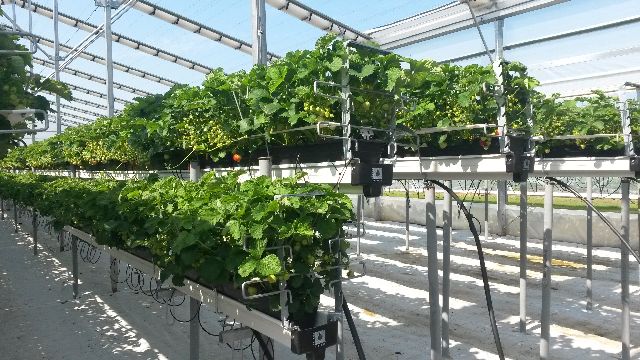Growing Greenhouse Strawberries Can Pay


Retractable roof greenhouses may have advantages over tunnels for some strawberry growers in some situations, according to an ongoing trial “across the pond.”
The trial was launched by Marks and Spencer, one of the premier retailers in the United Kingdom. It sets aside about $1 million a year to develop better ways to grow fruits and vegetables.
Total Worldfresh is the retail and procurement division of Total Produce UK. Its activities embrace every stage in the product life cycle, from plant breeding to production, from global importation to sourcing and supply. It’s a part of Total Produce, a $3.4 billion company that includes Total Berry, Total Cherry, etc.
Richard Vollebregt, chief executive officer of Cravo Equipment Ltd., a Canadian greenhouse manufacturer headquartered in Brantford, Ontario, met representatives of Total WorldFresh at Fruit Logistica, a huge trade show held each winter in Berlin, Germany. Vollebregt travels to trade shows around the world, and in discussions with Total Worldfresh, a project partnership to create a more sustainable strawberry production method that increases quantity and quality while reducing production inputs was proposed.
He became convinced the Cravo retractable roof greenhouse could alleviate many of the common strawberry production challenges, so the three companies partnered to launch the Strawberry Sustainability Project, growing strawberries in England in a Cravo automated retractable roof greenhouse.
“I couldn’t answer all of Total Fruit’s questions regarding growing strawberries as to yield, quality, etc. because each crop is unique,” says Vollebregt. “So all three companies contributed to the project, with the goal of creating a sustainable strawberry farm for the future.”
Tunnels Dominate
In the United Kingdom, virtually all berries are grown in tunnels because there is so much rainfall. “We don’t have to show them the benefits of covering the fruit,” says Vollebregt, “we have to show them the benefits of uncovering them from time to time.“
With tunnels, British growers struggled with climate control. High humidity inside the tunnels led to soft fruit and higher disease pressure. But with the retractable roof, they use a computer to control the roof and walls. This not only minimizes disease problems but, along with providing more light, it allows increased plant density.
The project build started in the spring of 2014 and the transplants were moved into the greenhouse in June 2014. This meant the normal fruit production time period was deferred by several months. Even so, results were very encouraging. This coming growing season will have demonstrable data, ready to compare to more traditional production methods.
During the first year, they were able to reduce fungicide use by 94% when compared with tunnel production, says Vollebregt. Yield per plant was increased by 22% — which he believes will increase by a wide margin through an earlier planting date this year. But more importantly, they got 96% No. 1 quality berries.
“Also they were happy because they put the berries through regular taste tests where they got great results and the berries had super-high Brix,” he says. Brix levels rose steadily as the season progressed, resulting in a harvest average of 10.8 with peaks of 13 and 16.
Better Growing Climate
The trials have some British growers rethinking how they grow berries, says Vollebregt.
“Berry growers worldwide spend 90% of their time thinking of what variety to use and how to better irrigate, how to better spray, not how to create a better environment,” he says. “So when we got a 94% reduction in fungicide use, not with a better variety, not with a better spray, we did it by creating a climate that prevented the disease from getting established.”
The variety they planted was Sonata, because they wanted to compare it to one of the varieties farmers are growing in the tunnels. Growers have traditionally selected from between short-day or long-day (day-neutral) varieties. Another aspect of the project was to enhance the profitability of the short-day, June bearing varieties.
Growers get longer yield duration from long-day (day-neutral) varieties, so producing an out out-of of-season, short- day crop, demonstrated the harvest manipulation possibilities created by the retractable roof. This year they will also plant long-day varieties, known as ever-bearers, as an adjacent trial within the greenhouse.
Few Insect Problems
As in the U.S., insects are a big problem for berry growers in the U.K. Also as in the U.S., perhaps the biggest single pest headache is spotted wing drosophila (SWD). Vollebregt says they are currently developing strategies on how to manage SWD with the greenhouse.
There is one obvious advantage with the retractable roof. With a tunnel, a grower has to open the walls for ventilation. With the retractable roof, both the roof and walls can be opened. A computer determines what gets opened when based on temperatures and wind speeds.
Insects obviously have to get inside the structure to do damage. How do they get in? With tunnels, the walls are open in summer, when there is high SWD pressure.
“You make it easy for the insects to migrate into tunnels, but with a retractable roof greenhouse, you can ventilate through the roof and keep the walls closed when the risk of SWD is high,” he says. “Walls go up 15 feet and most insects stay relatively close to the ground, usually 6 feet or less, because that’s where their food source is.”
Simply by changing the ventilation system from the walls to the roof, Vollebregt says you can reduce the insect pressure by about 90%. So you can reduce the amount you have to spray. If you spray in a tunnel, insects can go back in tomorrow. But if you spray in a retractable roof greenhouse, the rate of re-entry will be significantly lower.
Here is a short Cravo video on how growing in a retractable roof greenhouse can help control SWD. ●









